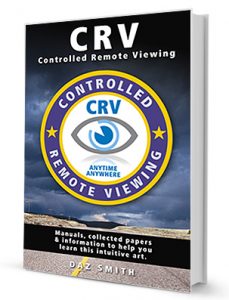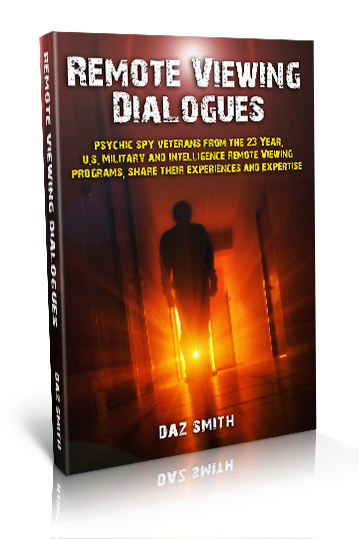CRV (Controlled Remote Viewing) & its manuals.
Controlled Remote Viewing (CRV), first known as Coordinate remote Viewing is the creation of the famous artist, author and remote viewer Ingo Swann.
Ingo Swann was a participant and sub-contractor for SRI (Stanford Research Institute) and their in house remote viewing effort from 1974 – 1985.
From 1979-1985 Ingo Swann was the lead in an effort to create a Remote Viewing training methodology that was to be taught to and later utilized by Intelligence clients of SRI. During this period Ingo was the first test subject in this new methodology, he later went on to teach it to Hal Puthoff, Jacques Vallee, Hella Hammid, Marsha Adams and a few other prototype trainees within SRI, circa 1981.
The initial results were promising allowing the Prototype training method to be expanded and later taught to the first wave of Intelligence people. Two people were selected for this but due to an illness only one trainee (Tom McNear) completed the full six stage CRV training in the prototype RV method. The initial prototype CRV training was comprised of one-to-one lectures, drills and lessons with Ingo Swann, repeated targets and lots of notes and essay writing that lasted a period of approx. two years.
Initially CRV was developed to have eight stages. (Coordinate remote viewing technology 1981-83, 4 August 1983, Author Ingo Swann). Two of these were later dropped or not included in the (Military CRV manual).
A second wave of four trainees started CRV training in 1984, these included known RV personalities Paul H Smith, Bill Ray and Edward Dames. This second wave of trainees did not complete the full six stage training as funding was cut short and the training program not continued with Ingo Swann teaching and at the helm.
The CRV training then continued in-house at INSCOM (january 1985), led by the knowledge from Tom McNear and the partly trained students. Whilst in CRV training with Ingo Swann, As owner of CRV, Ingo kept ALL the training materials and documents, he retained all the student lecture notes, and all the student essays and notes. (These today can be seen in the Ingo Swann archives at the University of West Georgia, on request.)
Because of this – the CRV trainees had to write their own manual or training notes of which CRV is most notably taught from today. This is the 1986 Manual.
A copy was sent to Ingo In 1986 to which he replied with the letter:
Pj Gaenir was the first to publicly post the CRV manual online in 1997. She states:
//The copyright of this document is attributed to Ingo Swann. Ingo however denies any credit for, participation in, or responsibility toward the document or its copyright. I called him and asked if I could post it. He said it wasn’t his and he didn’t care. It was written by Paul H. Smith. Paul however wrote it as a work for hire while employed by the DOD/DIA. The DIA did not classify the document, which in legal terms puts it in the public domain (the gov’t cannot copyright, they can only classify; unclassified materials are public record; nobody else can then claim ownership of what began a gov’t document).//
Probed further in a discussion, Ingo gave permission for this statement to be made.
I asked Ingo Swann for copyright permission to post this document. — PJ
The Coordinate Remote Viewing Manual
To which Ingo replied:
I did not write it.
PJ: But the copyright is credited to you.
I can’t help that.
PJ: Paul Smith says he’s the main author, but the methods are yours.
I have seen it, I don’t remember exactly what’s in it. It’s been re-edited a few times by various people to suit their needs. I believe it was a group-written document… [it wasn’t written by just one person].
PJ: I don’t have any way to know if the info in the manual is accurate….?
{pause…} I wasn’t asked to participate in [the writing of] it.
I found out it existed sometime after.
PJ: Your methods have become a very big deal, high priced, even cults have grown up around them or versions of them.
Just because I once played a role in the research, does not mean this role can be extended to cover everything that has happened in the field since then.
PJ: I could take the copyright cover off if you think it’s misleading.
If you do that people will say you’re editing it.
PJ: You don’t mind if I put it on the web?
I don’t care. You can say — please say this first, then I don’t care what is said after that — I did not write it.
I have never, ever written a document like that.
PJ: OK.
That’s what Ingo said about it, in a phone call Sunday, 24 May 1998, 4:15pm Eastern Time.
When the manual was first released online – Paul H Smith said this about the manual.
// In 1983-1984, six personnel from the military remote viewing unit at Ft. Meade participated in training contracted from SRI-International. This was the recently-developed coordinate remote viewing training, and the primary developer and trainer was the legendary Ingo Swann. One of the first trainees, was diagnosed with cancer, and was medically retired from active duty, terminating his training after only a few months. (The second, Tom McNear (his completed all training through Stage VI as the proof-of-principle “guinea pig.” His results were not just impressive. Some could even be considered spectacular.
Beginning in January of 1984, the remaining four of us began training with Ingo in California and New York. This contract lasted for a full year. Ed Dames, “Liam,” Charlene, and myself continued through until December (though Ed dropped out just before completion due to the birth of a son). We completed through Stage III training with Ingo. Towards the end of 1984 our patron and commander, Major General Burt Stubblebine was forced to retire and the RV program was threatened with termination. Consequently, no further contracts were let for training.
During the course of 1985, our future was very uncertain. However, the branch chief, together with Fred “Skip” Atwater (the training and operations officer), were hopeful that the unit would find a sponsor (which indeed happened) and decided to continue our training through Stage VI, with the help of Nance’s experience and considerable documentation and theoretical understanding that Atwater and others had managed to accrue.
At the conclusion of our training, and with a number of successful operational and training projects under out belts to show that CRV really did work, the further decision was made to try and capture in as pure a form as possible the Ingo methodology. The reasoning was that we might never get any more out-of-house training approved, yet we needed to be able to perpetuate the methodology even after the folks with the “institutional memory” eventually left the unit. I had developed the reputation of being the “word man” in the unit, plus Skip and the branch chief seemed to think I had a firm understanding and grasp of the theory and methodology, so I was asked to write a manual capturing as much of the CRV methodology as possible, with the assistance of the others who had been trained.
We pooled our notes, and I wrote each section, then ran it by the others for their suggestions and comments. Corrections and suggestions were evaluated and added if it could be established that they matched true “Ingo theory.” Skip and Tom both reviewed the manuscript and provided their input as well. When the thing was finally done, a copy was forwarded to Ingo, who deemed it a “comprehensive and accurate document.” Finally, Skip provided a three-page introductory section which it now turns out was apparently originally drafted by Joe McMoneagle. The finished version was printed at the DIA press in May 1986. It was a specialty run, and was never given an official DIA document number. I don’t believe any more than thirty or so were printed.
Things to keep in mind about the CRV manual: It wasn’t intended as a training manual per se, and certainly not as a stand alone training manual. It’s primary purpose was to capture and preserve for posterity Ingo’s methodology. The very first page declares that it was “prepared to serve as a comprehensive explanation of the theory and mechanics” of CRV, and as a “guide for future training programs.” We certainly didn’t develop it as a “how to.” Since we always assumed any further training to be done would either involve Ingo or someone who had already been trained, the manual did not incorporate lessons-learned, nor the practical implementation of CRV in an operational setting, nor even to explain how one taught people to do CRV, nor why CRV included certain points of theory and process in its methodological base. There are of course lots of things to be said about all these points, and we had ambitions at one time of writing a practical hands-on RV training manual. Unfortunately, events conspired against us and it never happened.//
The 1986 Military CRV manual can be downloaded here.
The Tom McNear CRV training Notes. Co-ordinate Remote Viewing Stages I-VI and beyond, February 1985.
After the release of the Star Gate FOIA documents by the CIA, I found the Tom McNear Training notes on 2 Feb, 2007 during a search of the files and released in online.
Tom McNear was the prototype trainee and the ONLY person in the military or intelligence (that we know of) to be fully trained by Ingo in the six stages of CRV. This document was written in 1985 after 3.5yrs of Ingo Swann CRV tutelage.
I personally find this set of CRV training notes more palatable than the later 1986 version. I also think the Hypothetical ‘next stages’ are something of interest to long term students.
Coordinate Remote Viewing Stages I-VI and beyond, February 1985 – download



